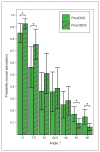Improving causality perception judgments in schizophrenia spectrum disorder via transcranial direct current stimulation
- PMID: 37402578
- PMCID: PMC10322162
- DOI: 10.1503/jpn.220184
Improving causality perception judgments in schizophrenia spectrum disorder via transcranial direct current stimulation
Erratum in
-
Correction to "Improving causality perception judgments in schizophrenia spectrum disorder via transcranial direct current stimulation".J Psychiatry Neurosci. 2024 Apr 23;49(2):E144. doi: 10.1503/jpn.240042. Print 2024 Jan-Feb. J Psychiatry Neurosci. 2024. PMID: 38653528 Free PMC article. No abstract available.
Abstract
Background: Deficient causality perception and attribution may underlie key symptoms of schizophrenia spectrum disorder (SSD), such as delusions and ideas of reference. Although transcranial direct current stimulation (tDCS) can increase the influence of spatial information on perceptual causality judgments among healthy participants, its effect among patients with SSD remains unknown. We sought to determine whether tDCS modulates the contribution of stimulus characteristics to perceptual causality judgments among patients with SSD; we predicted that right parietal tDCS would increase the influence of spatial stimulus characteristics on patients' causality perception.
Methods: Patients with SSD received frontal, parietal, frontoparietal and sham tDCS in 4 separate sessions. Pre- and post-tDCS, patients viewed video clips of ball A colliding with ball B. Spatial linearity (ball B's angle of egress) and temporal contiguity (delay between collision and ball B's movement) varied parametrically. After each launching event, patients rated perceived causality.
Results: Among 19 patients with SSD, we found a brain region-dependent effect of tDCS regarding sensitivity to violations of spatial linearity. After right parietal anodal tDCS, the influence of angle variations on patients' perceptual causality judgments increased, reflected by a higher probability of perceived causality for stimuli with small angles and a lower probability of perceived causality for stimuli with high angles.
Conclusion: Transcranial direct current stimulation increased the influence of spatial stimulus characteristics on causality perception among patients with SSD. Future research should explore potential links between tDCS-induced changes in basic perceptual processes and clinical symptoms, such as delusions and ideas of reference.
© 2023 CMA Impact Inc. or its licensors.
Conflict of interest statement
Competing interests: Rasmus Schülke took part in an educational event sponsored by Livanova, a manufacturer of vagus nerve stimulation devices. No other competing interests were declared. Funding: This work was supported by a research grant from the University Medical Centre Giessen and Marburg (25/2015MR), the German Research Foundation (Ki588/6-2, STR 1146/11-2, STR 1146/8-1, STR 1146/9-1 to Benjamin Straube) and The Adaptive Mind, funded by the Excellence Program of the Hessian Ministry of Higher Education, Science, Research and Art. The funding sources had no role in study design; the collection, analysis and interpretation of data; the writing of the report; and the decision to submit the article for publication.
Figures



Similar articles
-
Transcranial Direct Current Stimulation Improves Semantic Speech-Gesture Matching in Patients With Schizophrenia Spectrum Disorder.Schizophr Bull. 2019 Apr 25;45(3):522-530. doi: 10.1093/schbul/sby144. Schizophr Bull. 2019. PMID: 30304518 Free PMC article.
-
The role of the right parietal lobe in the perception of causality: a tDCS study.Exp Brain Res. 2011 Dec;215(3-4):315-25. doi: 10.1007/s00221-011-2899-1. Epub 2011 Oct 14. Exp Brain Res. 2011. PMID: 21997332
-
Space, time, and causality in the human brain.Neuroimage. 2014 May 15;92:285-97. doi: 10.1016/j.neuroimage.2014.02.015. Epub 2014 Feb 19. Neuroimage. 2014. PMID: 24561228 Free PMC article.
-
Transcranial direct current stimulation of the rLPFC shifts normative judgments in voluntary cooperation.Neurosci Lett. 2020 Feb 6;719:133164. doi: 10.1016/j.neulet.2017.10.020. Epub 2017 Oct 13. Neurosci Lett. 2020. PMID: 29037793 Review.
-
Transcranial Direct Current Stimulation for the Treatment of Refractory Symptoms of Schizophrenia. Current Evidence and Future Directions.Curr Pharm Des. 2015;21(23):3373-83. doi: 10.2174/1381612821666150619093648. Curr Pharm Des. 2015. PMID: 26088110 Review.
Cited by
-
Choice- and trial-history effects on causality perception in Schizophrenia Spectrum Disorder.Schizophrenia (Heidelb). 2025 Apr 17;11(1):65. doi: 10.1038/s41537-025-00614-0. Schizophrenia (Heidelb). 2025. PMID: 40246862 Free PMC article.
-
Correction to "Improving causality perception judgments in schizophrenia spectrum disorder via transcranial direct current stimulation".J Psychiatry Neurosci. 2024 Apr 23;49(2):E144. doi: 10.1503/jpn.240042. Print 2024 Jan-Feb. J Psychiatry Neurosci. 2024. PMID: 38653528 Free PMC article. No abstract available.
References
-
- Michotte AE. The perception of causality (Miles TR, Miles E, translators). London: Methuen; 1963.
-
- Schlottmann A, Ray ED, Mitchell A, et al. . Perceived physical and social causality in animated motions: spontaneous reports and ratings. Acta Psychol (Amst) 2006;123:112–43. - PubMed
-
- Scholl BJ, Tremoulet PD. Perceptual causality and animacy. Trends Cogn Sci 2000;4:299–309. - PubMed
-
- Blakemore SJ, Fonlupt P, Pachot-Clouard M, et al. . How the brain perceives causality: an event-related fMRI study. Neuroreport 2001;12: 3741–6. - PubMed
Publication types
MeSH terms
LinkOut - more resources
Full Text Sources
Medical
